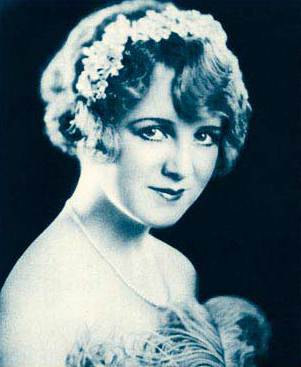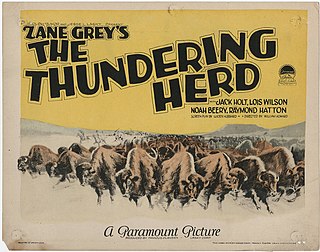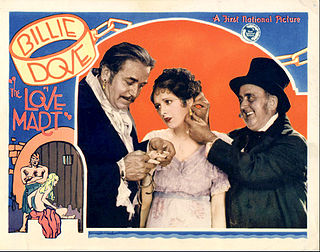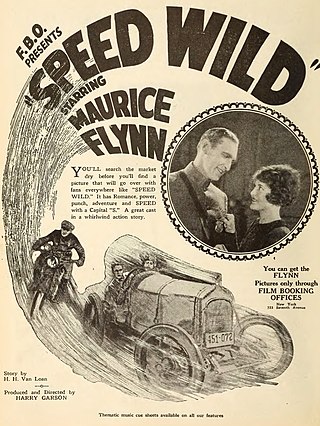Related Research Articles

Richard Semler Barthelmess was an American film actor, principally of the Hollywood silent era. He starred opposite Lillian Gish in D. W. Griffith's Broken Blossoms (1919) and Way Down East (1920) and was among the founders of the Academy of Motion Picture Arts and Sciences in 1927. The following year, he was nominated for the Academy Award for Best Actor for two films: The Patent Leather Kid and The Noose.

The Patent Leather Kid is a 1927 American silent drama film about a self-centered boxer who performs a heroic act in World War I that severely wounds him. It was directed by Alfred Santell and stars Richard Barthelmess, Molly O'Day, Lawford Davidson, Matthew Betz and Arthur Stone.

Marie Pauline Garon was a Canadian silent film, feature film, and stage actress.

The Thundering Herd is a 1925 American silent Western film, now lost. It is directed by William K. Howard and starring Jack Holt, Lois Wilson, Noah Beery, Sr. and Raymond Hatton. Based on Zane Grey's 1925 novel of the same name and written by Lucien Hubbard, the film is about a trader who uncovers a scheme to blame the Indians for a buffalo-herd massacre. It was one of a series of critically and commercially successful Zane Grey westerns produced by Jesse Lasky and Adolph Zukor for Paramount Pictures.

John F. Gavin was a pioneer Australian film actor and director, one of the early filmmakers of the 1910s. He is best known for making films about bushrangers such as Captain Thunderbolt, Captain Moonlite, Ben Hall and Frank Gardiner. Known informally as 'Jack', Gavin worked in collaboration with his wife Agnes, who scripted many of his films.

Frank Campeau was an American actor. He appeared in more than 90 films between 1911 and 1940 and made many appearances in films starring Douglas Fairbanks.

The Captive is an American silent-era film released on April 22, 1915. It was released on five reels. The film was written, directed, edited, and produced by Cecil B. DeMille. Jesse L. Lasky was another producer and Jeanie MacPherson worked with DeMille to write the screenplay. The film is based on a play written by Cecil B. DeMille and Jeanie MacPherson. The Captive grossed over $56,000 on a budget of $12,154. Blanche Sweet stars as Sonia Martinovich, alongside House Peters who stars as Mahmud Hassan. The film details the romantic war-era plight of Sonia and her lover Mahmud.

The Love Mart is a 1927 American silent drama film directed by George Fitzmaurice starring Billie Dove, Gilbert Roland and Noah Beery, and featuring Boris Karloff. The film is lost.

The Moving Picture World was an influential early trade journal for the American film industry, from 1907 to 1927. An industry powerhouse at its height, Moving Picture World frequently reiterated its independence from the film studios.
The Traffic Cop is a 1926 American silent drama film directed by Harry Garson and starring Maurice 'Lefty' Flynn, Kathleen Myers, and Nigel Barrie.

The No-Gun Man is a 1924 American silent Western film directed by Harry Garson and starring Maurice 'Lefty' Flynn, William Quinn, and Gloria Grey.

Sir Lumberjack is a 1926 American silent drama film directed by Harry Garson and starring Maurice 'Lefty' Flynn, Kathleen Myers, and Tom Kennedy.

Smilin' at Trouble is a 1925 American silent Western film directed by Harry Garson and starring Maurice 'Lefty' Flynn, Helen Lynch and Kathleen Myers. Location shooting took place around San Pedro and at a dam construction site, likely the Pit 3 Dam in Northern California.

Speed Wild is a 1925 American silent action film directed by Harry Garson and starring Maurice 'Lefty' Flynn, Ethel Shannon, and Frank Elliott.

Heads Up is a 1925 American silent comedy adventure film directed by Harry Garson and starring Maurice 'Lefty' Flynn, Kathleen Myers, and Kalla Pasha.

Universal City Zoo was a private animal collection in southern California that provided animals for silent-era Universal Pictures adventure films, circus pictures, and animal comedies, and to "serve as a point of interest" for tourists visiting Universal City. The animals were also leased to other studios. The zoo was closed in 1930, after cinema's transition to synchronized sound complicated the existing systems for using trained animals onscreen.

Harry Burns was a vaudeville performer, boxing referee, actor, assistant director, animal-picture director and producer, and Hollywood magazine publisher. Burns was married to the actress Dorothy Vernon; the silent-film slapstick comedy star Bobby Vernon was his stepson.

Algernon Maltby "Curley" Stecker was an early Hollywood animal trainer, Universal City Zoo superintendent, animal-film producer, and occasional actor-stuntman.

Otto F. Breitkreutz, universally known as Big Otto, was an American circus man and film producer during the early 20th century. He was called Big Otto because he weighed somewhere between 350–480 lb (160–220 kg) and was "big in heart and policy."

William Alban Ulman Jr. was a film screenwriter, magazine writer and U.S. Army officer. He is best known today for his involvement in the photographic record of D-Day. A persistent legend of D-Day is that important footage of the landings was dumped into the English Channel. Maj. W.A. Ulman is mentioned in at least two memos regarding film of the landings and as such has historically been considered a "suspect" in the lore of D-Day.
References
- 1 2 3 4 5 "Vet Comedian of 500 Films Now a Private". The Baltimore Afro-American. 6 April 1943. p. 8. Retrieved 17 April 2023.
- 1 2 "Chances of Men Better in Films". The Evening Huronite. 16 March 1929. p. 5. Retrieved 6 May 2023.
- 1 2 Nida (10 February 1928). "Side Lights of the Stage and Screen". The Amarillo Globe. p. 7. Retrieved 22 April 2023.
- 1 2 3 4 5 Mason, Buddy (21 June 1930). "Traveling the Rocky Road to Fame: Raymond Turner Conquers Tremendous Obstacles to Achieve Success in Movies". The Afro-American. p. 8. Retrieved 16 April 2023.
- ↑ Katchmer, George A (2002). A Biographical Dictionary of Silent Film Western Actors and Actresses. McFarland. p. 379.
- 1 2 Garson, Harry; Flynn, Lefty (1924), The No-Gun Man , retrieved 2023-05-06
- 1 2 Garson, Harry; Flynn, Lefty (1925), Speed Wild , retrieved 2023-05-06
- 1 2 Garson, Harry (1925), Heads Up , retrieved 2023-05-06
- 1 2 Garson, Harry; Flynn, Lefty (1926), Sir Lumberjack , retrieved 2023-05-06
- 1 2 Garson, Harry; Flynn, Lefty (1926), The Traffic Cop , retrieved 2023-05-06
- ↑ Regester, Charlene (1997). "African American Extras in Hollywood During the 1920s and 1930s". Film History. 9 (1): 103. JSTOR 3815293 – via JSTOR.
- ↑ "Dick Barthelmess at Edwards Today". Sarasoia Herald. 5 December 1929. p. 7. Retrieved 16 April 2023.
- ↑ "Raymond Turner in "The Love Mart"". The Afro American, Baltimore. 17 December 1927. p. 7. Retrieved 8 May 2023.
- 1 2 Fitzmaurice, George; Dove, Billie (1927), The Love Mart , retrieved 2023-04-16
- 1 2 3 Turner, Kofi Charu Nat (2022). Caffie Greene and Black Women Activists. Routledge.
- ↑ "1950 United States Federal Census for Caffie M Turner". ancestry.co.uk. Retrieved 5 May 2023.
- ↑ Woo, Elaine (7 June 2010). "California: Caffie Greene dies at 91; activist was a leader in creation of King/Drew hospital". The Los Angeles Times. Retrieved 16 April 2023.
- 1 2 "Raymond Douglas Turner (1895-1981) - Find a Grave..." www.findagrave.com. Retrieved 2023-04-16.
- ↑ McGowan, J. P. (1922), Hills Of Missing Men , retrieved 2023-04-16
- ↑ Campbell, William (20 June 1925). "Pre-Release Reviews of Features: Speed Wild". Motion Picture News: 3071 – via lantern.mediahist.org.
- ↑ Garson, Harry (1925), Smilin' At Trouble , retrieved 2023-05-06
- ↑ Campbell, William (2 May 1925). "O.U. West". Motion Picture News. XXXI (18): 1960 – via lantern.mediahist.org.
- ↑ Pardy, George T (21 November 1925). "Heads Up". Motion Picture News. XXXII (21): 2460 – via lantern.mediahist.org.
- ↑ Pardy, George T (27 February 1926). "Pre-Release Reviews of Features: The Traffic Cop". Motion Picture News. XXXIII (9): 1010 – via lantern.mediahist.org.
- ↑ "Actor in Demand". Oakland Tribune. 25 December 1927. pp. S-7. Retrieved 8 May 2023.
- ↑ Brabin, Charles J.; Sills, Milton (1927), The Valley Of The Giants , retrieved 2023-05-08
- ↑ Werker, Alfred L.; Thomson, Fred (1928), Kit Carson , retrieved 2023-05-08
- ↑ Ray, Albert; Meeker, George (1928), A Thief In The Dark , retrieved 2023-05-08
- ↑ "Silent Era : Progressive Silent Film List". www.silentera.com. Retrieved 2023-04-16.
- ↑ "U.S., World War II Draft Cards Young Men for Raymond Douglas Turner".
- ↑ "1940 United States Census for Raymond D Turner". ancestry.co.uk. Retrieved 5 May 2023.
- ↑ "1950 United States Federal Census for Raymond D Turner". ancestry.co.uk. Retrieved 5 May 2023.